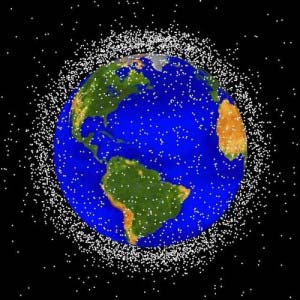Since the early days of the Space Age spent rocket stages, decommissioned satellites, and rubbish of all kinds have contaminated near-Earth space. At present more than 100 million pieces of human-made debris ranging in size from dead satellites to flecks of paint whiz around the Earth at incredibly fast speeds. This cloud of space junk poses a threat to our space infrastructure on which we now depend so much for navigation, communication, Earth surveillance, and scientific and industrial data collection, because even small fragments of a disintegrated spacecraft can seriously damage other satellites.
Does the creation of space debris mean that humanity has extended the “industrial sphere” into near-Earth space? Historian Lisa Ruth Rand, A PhD candidate at the University of Pennsylvania, discusses this question on episode 67 of Exploring Environmental History. She also examines why environmental historians should study the expansion of humanity beyond earth and other space environmental history related issues.
Further reading & resources
Lisa Ruth Rand, “Gravity, the Sequel: Why the Real Story Would Be on the Ground”, The Atlantic, 28 February 2014.
Lisa Ruth Rand, “How Apollo Astronauts Took Out the Trash. One small step for garbage. One giant leap for garbage-kind”, Popular Mechanics, 21 July 2015.
Jan Oosthoek, “New horizons: space, a new frontier for environmental historians”, Environmental History Resources, 16 July 2015.
Pyne, Steve. “Extreme Environments”, Environmental History 15 (2010) 3, 509-513.
Music credit
“The Astronaut” by timberman, Available from ccMixter

Recent Comments